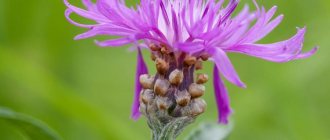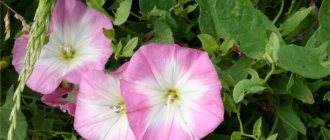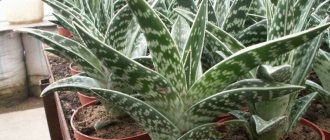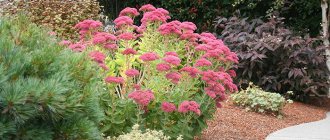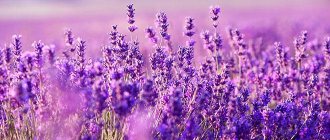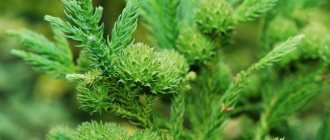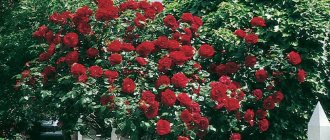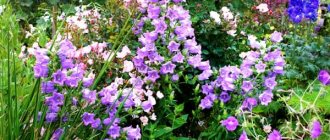In nature, edelweiss grows at an altitude of about 2 thousand meters above sea level, in the alpine and subalpine zones. This zone is characterized by high levels of ultraviolet radiation and low air humidity. That's why edelweiss trees have such thick silvery pubescence. It is not only beautiful, it protects the plant from excessive loss of moisture. By the way, by the degree of “pubescence” of a plant, one can tell how high above sea level it grew: the lower, the less pubescence, up to its complete loss.
- Edelweiss and Leontopodium: where did the name come from?
- Appearance
- Alpine edelweiss and features of its cultivation in the middle zone Reproduction of edelweiss Reproduction by dividing the bush
- Propagation by seeds
Edelweiss and Leontopodium: where did the name come from?
The scientific name Leontopodium consists of two Greek words: “leon” (λέων, leon) - lion and “podion” (ποδεών, podion) - paw, i.e. lion's paw . Where did this name come from? Everything is clear without words, just look at the fluffy edelweiss flower, so similar to the paw of a snow leopard.
And the name edelweiss itself is a combination of two German words “edel” - “noble” and “weiß” - “white”, i.e. noble white. And you can't argue with that either.
Edelweiss flower
By the way, in France, edelweiss is known as the Alpine star, and in Italy it is the silver flower of the rocks.
Legends
So what legends surround the edelweiss flower, what secrets does it keep?
- White is the color of spiritual purity, which is why edelweiss has long been associated with the soul. One of the legends says that lovers threw themselves off a cliff, unable to come to terms with the need to part. At the site of their death, edelweiss flowers grew as a symbol of grief.
- Another story tells of the "mountain witch stars" who raise and nurture them. The thing is that edelweiss flowers remain fresh and fragrant for a long time, even if they are picked. Hence the idea that these are the tricks of magicians or witches protecting their natural treasures.
- One of the most romantic and dramatic legends was invented by the peoples of Western Ukraine: two twin brothers, fighting for the heart of a beautiful lady, decided to find out whose love was stronger. Whoever brings the girl an unusually beautiful mountain flower wins. While climbing the rocks, one of the brothers fell. A relative tried to catch him, but this only killed them both. The upset girl jumped into the abyss out of grief.
Edelweiss is a mountain plant, so legends are often associated with the difficulty of collecting it
Thus, edelweiss combines the bitter dramas of unhappy love, issues of life and death, magic and mysticism, and enchantment. For everyone, edelweiss has prepared something of its own, so homely and close to the heart that it is impossible not to experience the legend “in your own skin.”
Appearance of edelweiss
More than 30 species are known, which in nature are distributed in the mountainous regions of Eurasia (mainly in Southeast Asia), excluding the Caucasus, Western Asia and South America.
All representatives are rhizomatous perennial or annual plants, from 10 to 30 cm in height. Inflorescences are small baskets, collected in capitate inflorescences, surrounded below by a rosette of pubescent leaves. The flowers themselves are very small, yellowish or white.
Himalayan edelweiss blooming.
Edelweiss blooms in summer: July - August.
alpine edelweiss (Guaphalium alpinum, Leontopodium alpinum) is mainly used . Several more species can be found in botanical gardens and private collections.
Characteristics of popular varieties
There are more than 40 plant species in floriculture. Of these, only five varieties have reached widespread distribution:
- Edelweiss alpine. The terry apical leaves form a multi-rayed star. The pride of the Alpine edelweiss is the fleecy silver leaves of a lanceolate shape, forming a basal rosette. The stem of the plant reaches a height of 20 centimeters.
- Siberian. A genus close to the alpine grows in the steppe and mountainous regions of Korea, Mongolia and Siberia. Large bushes are decorated with miniature inflorescences. The plant develops in permeable, dry and unfertilized soil. Propagated by spring division of rhizomes or seeds in summer.
- Pale yellow. Single stems are covered with sparse oblong leaves. The edges of the leaves are curled and have a pale yellow or greenish color. The inflorescence star rarely has the correct geometric shape.
- Kuril. The flower, reaching a height of no more than 18 cm, is squat. Straight stems are decorated with felted drooping leaves. The shape is narrow-lanceolate.
- Two-color. The difference is soft felt leaves near the inflorescences. Distributed in Japan and Sakhalin. The variety prefers rocky sea slopes and river banks.
Alpine edelweiss and features of its cultivation in the middle zone
Alpine edelweiss naturally grows at high altitudes in the mountains, like all its relatives.
Alpine edelweiss is a small silvery bush, about 25-30 cm high, with branched stems and small gray leaves. It blooms in July-August, for 20-25 days.
Alpine edelweiss flowers
Externally, Alpine edelweiss can be quite different from each other. This is due, as mentioned above, to the height of their growth. To preserve the characteristics of the plant, it is better to propagate edelweiss vegetatively. Or use seeds only from trusted producers for sowing.
Collection, preparation, storage
The decorative qualities of Leontopodium led to its mass extermination. Travelers in the mountains like to take the silver star with them, so the plant is listed in the Red Books of many countries and is not harvested in the wild.
To use the medicinal properties of edelweiss, you need to grow it on your own plot. The shoots are harvested during flowering. They are cut with scissors, laid out on paper and dried in the shade under a canopy, stirring occasionally. You can dry the plant by tying it in bunches and hanging it in a ventilated area. Finished raw materials are stored in paper or cloth bags for no more than three years.
To use the medicinal properties of edelweiss, you need to grow it on your own plot.
Edelweiss propagation
Propagation of edelweiss by dividing the bush
It is best to divide edelweiss bushes in early spring or early autumn. There are no special secrets here, just carefully divide the bush and plant the divisions in the ground in a permanent place with a distance of at least 25 cm.
Edelweiss variegated, Edelweiss bicolor, Edelweiss bicolor (Leontopodium discolor) - bushes up to 30-35 cm tall. Flowers up to 4 cm in diameter.
Propagation of edelweiss by seeds
Alpine edelweiss seeds can be freely purchased online.
Method: sowing seedlings in seedling pots
Sow the seeds at the end of February - in March for seedlings in pots. Make soil for edelweiss seedlings from soil, perlite and sand in approximately equal proportions. Sow the seeds on the surface, lightly pressing them into the soil. Spray the seeds from above with a spray bottle and cover the crops with glass or film.
The seeds germinate quickly: within a week or two, shoots will appear. But then the edelweiss sprouts will develop quite slowly. Keep edelweiss seedlings in a bright but cool place.
The main thing in growing edelweiss seedlings is not to overwater or overdry.
In May, plant the seedlings in a permanent place. Edelweiss will bloom next season.
Method: sowing seedlings in large flower pots
Since edelweiss seedlings are very small and weak, the first year they can not be planted in the ground, but grown in pots until the end of summer, and in the fall the pots can be buried in the area. Once the edelweiss bush has reached a sufficient size, they can be planted in the garden in a permanent place, in spring or late summer.
Edelweiss alpine
If you choose the second path, then when sowing seeds, choose larger pots so that the plants are comfortable. In this case, you cannot sow edelweiss in small specialized pots for seedlings; their size will not be sufficient for plant growth throughout the season.
Method: direct sowing into the ground
And the third method of seed propagation of edelweiss is direct sowing into the ground. Edelweiss seeds are sown directly into the ground in May, shoots appear in June.
Care Tips
It is better to plant edelweiss seedlings in separate bushes; it does not like competitors
Conditions for growing edelweiss
For successful growth of edelweiss, it is necessary to comply with the plant requirements for growing conditions. When planting, just keep in mind what edelweiss likes and dislikes.
Containers with edelweiss bushes for planting in the garden
Edelweiss likes:
- Sunny location
- Dry, well-drained soil, enriched with lime, moderately fertile.
- The presence of fine crushed stone or coarse sand in the soil.
- Weeding, without loosening.
Edelweiss does not like:
- Shady location.
- It's hot.
- Dampness.
- Fertilizers! Edelweiss does not like either organic matter or mineral additives.
- Loosening the soil.
- Watering (except on very hot and dry summer days).
It is useful to mulch edelweiss trees for the winter. Severe frosts can damage the plant, but, as a rule, it recovers quickly.
In addition to alpine edelweiss, you can sometimes find and purchase for your collection such species as: Kuril, Siberian, pale yellow and edelweiss edelweiss. The differences in appearance between the species are small, and their growing conditions are the same.
Siberian edelweiss, or Pilibina (Leontopodium palibinianum, Leontopodium sibiricum) is similar to alpine edelweiss. But its bushes are larger, and its flowers, on the contrary, are smaller. Blooms June-September
Application
The most popular area of application of the plant is cosmetology. Flower extract is often used as an important ingredient in cosmetics that have a positive effect on the skin. It is extracted using the alcohol-glycerin extraction process, using the above-ground component of the plant. The result is an orange or dark brown extract with no aroma.
This extract is of great benefit, as it has antioxidant properties, promotes the regeneration process, is a good remedy for preventing skin aging, and can be a good antiseptic.
The extract is an important component in the production of creams and serums. Its use is not recommended only in the case of individual intolerance.
Pest control and disease prevention
The American flower does not have many pests, which makes it easier to care for. The most dangerous is the onion root mite, which parasitizes the bulb and can lead to the death of the plant. You can determine the presence of a tick:
- by white coating on the leaves and their deformation;
- yellow spots appear on the bulb, it wrinkles;
- Rot or mold may appear in tick habitats.
Acaricides are used against ticks. A safer method is to pour a nettle decoction under the root of the plant. Pour 1 kg of nettle into 5 liters of boiling water. The infusion should ferment for 5 days. Then dilute in a ratio of 1:10. The appearance of the parasite can be prevented. Before planting, place the bulbs in hot water for half an hour. Bulbs infected with mites must be destroyed.
The most common diseases are fungal and various types of rot. For prevention, treat planting material with fungicides.
Location
Edelweiss can be found not only in the Alps, but also in other mountainous regions of Europe and Asia, in Siberia, the Far East and Japan. These plants are usually grown in rock gardens, in conditions similar to those in the regions of their natural habitat, since this is the only way to preserve the charm and delicate white fluff of edelweiss.
Blooming edelweiss (Photo from open source)
For many years, the collection of mountain edelweiss was completely uncontrolled, which brought these plants to the brink of extinction.
Diseases and pests of edelweiss
The flower is considered one of the most resistant to almost any pests, and it rarely gets sick, but it also has natural enemies.
Diseases
Edelweiss is only afraid of stagnation of water in the soil. Overmoistening of the soil leads to rotting of the root system. A flower can be saved either by an artificially created drought, which is almost impossible to achieve, or by transplanting it into dry soil, which is also problematic. It is much easier to simply not flood the plant and cover it during the rainy season.
Pests
The only parasitic insect against which edelweiss is defenseless is aphids. To get rid of the pest, the plant is treated with insecticides. Folk methods against aphids if they infect edelweiss are powerless.
Description
The mountain edelweiss is a modest and delicate flower, captivating with its simplicity and shape. The basket inflorescences are painted yellow; their simple appearance is beautifully set off by pointed leaves. Having an unusual silvery color, they found the name of the Alpine stars. Their top is darker than the underside, which is densely covered with white felt. The silver and white color scheme is valued by florists for its originality. They are happy to use fresh and dried edelweiss flowers in bouquets.
Cut alpine stars retain their shape and color when dried. They can be safely used in herbariums and ikebana.
In the flowerbed, the flowers get along with their neighbors and do not overwhelm them with their lush growth. However, they look best against the background of stones. They are recommended to be combined with rock and coniferous trees.
Comments (4)
28.11.2019 at 15:59 | #
I would never have thought that edelweiss could be grown on a plot. I have to try it - however, I have never seen seeds in a store, unless I ordered them by mail... Moreover, it is a perennial.
Yulia Expert Plodogorod
30.11.2019 at 01:24 | #
Hello, Elya! Edelweiss propagates quite easily using seeds, so you can order them online. It is only important that the planting material is not old. We recommend using the seedling method. If you have already had experience cultivating any flowers or even vegetables through seedlings, this process will not be too difficult.
Planting time depends on the climate of the region of residence. If it is warm enough, you can sow edelweiss seedlings even at the end of winter. It is advisable to disinfect the soil mixture before use. To do this, the soil is poured with boiling water to which boric acid has been added or fried in the oven. This is important because a flower that is hardy in adulthood in the form of seedlings is quite vulnerable.
It is important not to bury the planting material, but to spread it on the surface of the soil in a prepared container. It's better to do it as evenly as possible. Since seeds take a long time to germinate, we recommend monitoring the humidity in the container. Although it is covered with film or glass, the soil will still dry out. It is better to moisturize from a spray bottle and only with warm water.
Although the shelter is completely removed only when seedlings appear, it is important to regularly ventilate the planting for a few minutes. It is important that mold does not appear on the surface of the soil. Disinfecting the soil reduces this likelihood, but it is still possible. In the described case, the immediate moistening should be carried out with a manganese solution.
Stratification before sowing increases plant immunity, according to some reviews, increases germination, but, in general, if the timing is already approaching, you can do without such a procedure.
It is better to pick in glasses or peat tablets. So the likelihood of injuring the root system when transplanting into open ground is minimal. We would like to note that it is also worth hardening before transplanting. This means that the seedlings need to begin to get used to the new microclimate.
For the first time, it is worth leaving the flowers in a slightly shaded and protected place for an hour or two. Over time, we recommend increasing the duration of walks. Before planting in the ground, it is worth leaving the seedlings overnight and assessing how ready the plants are for their new place of residence.
Before planting, it is better to water the holes with a weak solution of fungicide. To ensure that sensitive seedlings are protected from weeds, we recommend planting them on agrofibre.
Andrey
12/27/2019 at 12:14 pm | #
Growing edelweiss in a garden plot is not an easy task. My experience is negative. As I understand it, the flower is adapted to exist in conditions of high humidity, literally in the clouds.



